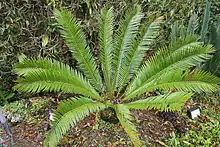| Encephalartos equatorialis | |
|---|---|
 | |
| Scientific classification | |
| Kingdom: | Plantae |
| Clade: | Tracheophytes |
| Clade: | Gymnospermae |
| Division: | Cycadophyta |
| Class: | Cycadopsida |
| Order: | Cycadales |
| Family: | Zamiaceae |
| Genus: | Encephalartos |
| Species: | E. equatorialis |
| Binomial name | |
| Encephalartos equatorialis P.J.H.Hurter 1995 | |
| Synonyms | |
|
Encephalartos imbricans Vorster | |
Encephalartos equatorialis is a species of cycad that is found on two granite hills on the eastern shore of Thurston Bay, Lake Victoria, Uganda at elevations up to 1000 meters.[2]
Description
The cycad is 3.5–4 m tall and 35–45 cm in diameter. Its dark green leaves are rigid, 3–4 m long, and 30–40 cm broad, with a petiole up to 13 mm long. The leaflets, 20-25 cm long and about 20 mm wide, angle at 30° from the rachis. This dioecious species has male cones of 30–40 cm length and 9–10 cm diameter, and oblong microsporophylls of 20–30 mm by 10–15 mm. Its female cones are 35–40 cm long, 18–20 cm in diameter, with rhomboid macrosporophylls measuring 55 mm by 60 mm with a height of 30 mm. Each cone holds about 200 ellipsoidal seeds, 35–38 mm long and 23–30 mm in diameter, with an orange-red sarcotesta.[3]
References
- ↑ Donaldson, J.S. (2010). "Encephalartos equatorialis". IUCN Red List of Threatened Species. 2010: e.T41887A10569026. doi:10.2305/IUCN.UK.2010-3.RLTS.T41887A10569026.en. Retrieved 12 November 2021.
- ↑ "Encephalartos equatorialis in Tropicos".
- ↑ Hurter, P.J.H.; Glen, H.F. (1995). "Encephalartos equatorialis (Zamiaceae): a newly described species from tropical Africa". South African Journal of Botany. 61 (4): 226–229. doi:10.1016/S0254-6299(15)30519-6.
External links
 Media related to Encephalartos equatorialis at Wikimedia Commons
Media related to Encephalartos equatorialis at Wikimedia Commons Data related to Encephalartos equatorialis at Wikispecies
Data related to Encephalartos equatorialis at Wikispecies
